Recent Water Damage Posts
6 Essential Tips to Mitigate Flooding Risks in West Valley City, UT
5/18/2024 (Permalink)
 Mitigate Flooding Risks in West Valley City, UT
Mitigate Flooding Risks in West Valley City, UT
West Valley City, nestled in the picturesque Salt Lake Valley, is a vibrant community that faces its share of weather-related challenges, notably flooding. With its unique geographical features and seasonal climate patterns, the city occasionally experiences flooding, posing risks to property, infrastructure, and public safety. However, with proactive measures and community involvement, residents can significantly reduce the impact of flooding events. In this article, we'll explore six essential tips to mitigate flooding risks in West Valley City, UT.
1. Understand the Geography and Drainage Systems:
The first step in mitigating flooding risks is to understand the geography and drainage systems of West Valley City. Being situated in a valley means the city is prone to flooding, especially during heavy rainstorms or snowmelt. Residents should familiarize themselves with the local topography, including low-lying areas and nearby water bodies such as streams, rivers, and retention basins. Additionally, knowledge of the city's drainage infrastructure, including stormwater drains and retention ponds, is crucial. Understanding how water flows through the city helps residents identify potential flood-prone areas and take appropriate precautions.
2. Maintain Clear Drainage Pathways:
One of the most effective ways to prevent flooding is to ensure that drainage pathways remain clear and unobstructed. Residents should regularly inspect and maintain gutters, downspouts, and storm drains on their properties to prevent debris buildup, which can impede water flow during heavy rainfall. Additionally, keeping streets and sidewalks clear of leaves, branches, and other debris helps maintain efficient surface drainage. By taking proactive measures to keep drainage pathways clear, residents can minimize the risk of localized flooding in their neighborhoods.
3. Implement Green Infrastructure Practices:
Green infrastructure refers to nature-based solutions designed to manage stormwater and reduce flooding risks. In West Valley City, residents can implement green infrastructure practices on their properties to help absorb and infiltrate rainwater, reducing the volume of runoff entering the stormwater system. Examples of green infrastructure techniques include installing rain gardens, permeable pavement, and vegetated swales. These features not only enhance the aesthetic appeal of neighborhoods but also provide ecological benefits by promoting biodiversity and improving water quality.
4. Invest in Flood Protection Measures:
For residents living in flood-prone areas or near water bodies, investing in flood protection measures is essential. This may include installing flood barriers, such as sandbags or flood gates, around homes and businesses to prevent water intrusion during flood events. Elevating electrical systems, appliances, and valuables above potential flood levels can also minimize damage. Additionally, retrofitting buildings with waterproofing materials and backflow prevention devices can help mitigate flood risks. By taking proactive steps to protect their properties, residents can minimize the financial and emotional toll of flooding disasters.
5. Participate in Community Flood Preparedness Efforts:
Flooding is a community-wide issue that requires collective action to address effectively. Residents can participate in community flood preparedness efforts by joining neighborhood associations, attending local workshops, and engaging with city officials and emergency management agencies. By staying informed about flood risks and evacuation procedures, residents can better prepare themselves and their families for potential emergencies. Community involvement also fosters resilience and strengthens social cohesion, enabling neighborhoods to effectively respond to and recover from flooding events.
6. Support Sustainable Development Practices:
As West Valley City continues to grow and develop, it's essential to prioritize sustainable land use and development practices that mitigate flooding risks. This includes implementing stormwater management regulations, preserving natural floodplains, and promoting low-impact development techniques. By integrating green infrastructure into new construction projects and retrofitting existing infrastructure to improve resilience, the city can reduce its vulnerability to flooding while enhancing environmental sustainability. Residents can support sustainable development practices by advocating for responsible land use policies and participating in planning processes that prioritize flood resilience.
Flooding poses significant risks to communities, but proactive measures can help mitigate these risks and build resilience. In West Valley City, residents can take several steps to reduce the impact of flooding events, from understanding the local geography and drainage systems to investing in flood protection measures and supporting sustainable development practices. By working together as a community and implementing these essential tips, residents can minimize the threat of flooding and ensure a safer, more resilient future for West Valley City, UT.
SERVPRO of West Valley City's Expertise in Resolving Water Damage from Leaking Toilets
1/15/2024 (Permalink)
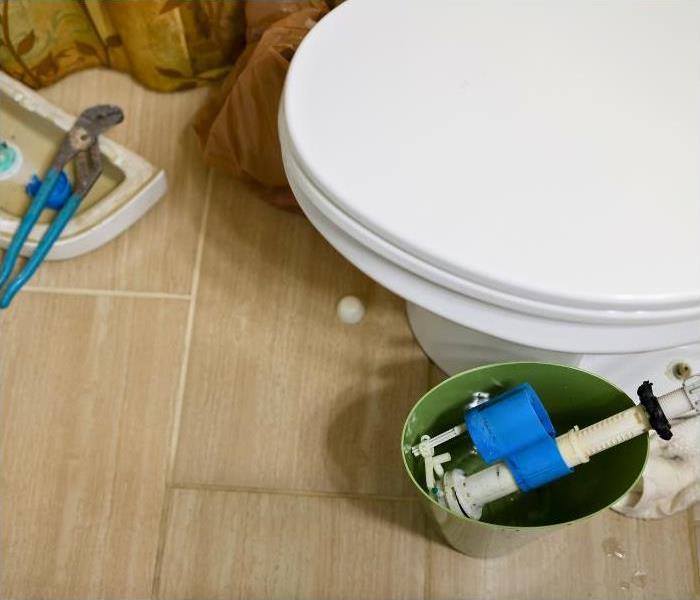 Leaking toilet in West Valley City, UT.
Leaking toilet in West Valley City, UT.
Water damage in residential homes can be a nightmare for homeowners, wreaking havoc on property and belongings. One of the most common culprits is a leaking toilet, a seemingly minor issue that can lead to significant problems if not addressed promptly. In this blog post, we will explore the impact of water damage caused by a leaking toilet and shed light on how SERVPRO of West Valley City acts swiftly to mitigate damage and restore homes to their preloss condition.
The Hidden Perils of a Leaking Toilet:
A leaking toilet may seem like a minor inconvenience at first, but its consequences can be far-reaching. The continuous drip of water can permeate flooring, walls, and even seep into structural components, causing hidden damage that may not be immediately apparent. Mold growth is another concern, as the moist environment created by water leaks provides an ideal breeding ground for these troublesome fungi.
Homeowners often underestimate the potential severity of water damage from a leaking toilet, assuming that a simple DIY fix will suffice. However, time is of the essence when dealing with water damage, and quick action is crucial to preventing further harm to the property.
The Importance of Swift Mitigation:
Water damage can escalate rapidly, leading to structural issues, electrical hazards, and compromised indoor air quality. Swift mitigation is essential to minimize the extent of the damage and reduce the likelihood of secondary issues such as mold growth.
SERVPRO of West Valley City understands the urgency of water damage situations and responds promptly to mitigate the damage. Their team of highly trained professionals is equipped with state-of-the-art tools and technology to assess the extent of the damage, extract water, and implement drying techniques efficiently.
Immediate Response and Assessment:
Upon receiving a call, SERVPRO of West Valley City dispatches a team to the affected property without delay. The first step is a thorough assessment to determine the scope of the water damage. Specialized moisture detection equipment is used to identify hidden pockets of water behind walls, under flooring, and within structural components.
Once the assessment is complete, the team develops a tailored mitigation plan, taking into account the specific characteristics of the water damage. This plan outlines the steps required to restore the property to its pre-damage condition and includes a timeline for each phase of the restoration process.
Water Extraction and Drying:
The next crucial step is the removal of standing water and moisture from the affected areas. SERVPRO of West Valley City employs powerful water extraction equipment to efficiently remove excess water, preventing further damage to the property.
State-of-the-art drying equipment, such as industrial-grade dehumidifiers and high-speed air movers, is strategically placed to expedite the drying process. This not only prevents the growth of mold but also helps salvage materials that may otherwise be irreversibly damaged.
Meticulous Restoration:
Once the affected areas are thoroughly dried, the restoration process begins. SERVPRO of West Valley City focuses on restoring rather than replacing, whenever possible, to minimize costs and reduce the disruption to homeowners. This may involve repairing or replacing damaged drywall, flooring, and other structural elements.
In cases where materials cannot be salvaged, the SERVPRO team ensures that replacements match the existing materials, maintaining the aesthetic integrity of the home. Throughout the restoration process, homeowners are kept informed of progress, ensuring transparency and peace of mind during a challenging time.
Preventing Future Water Damage:
In addition to mitigating current water damage, SERVPRO of West Valley City takes proactive measures to prevent future incidents. This may include identifying and addressing the root cause of the leaking toilet, recommending plumbing repairs, or providing advice on routine maintenance to homeowners.
Education is a key component of SERVPRO's approach, empowering homeowners to recognize and address potential water damage risks before they escalate. By taking a holistic approach to water damage restoration, SERVPRO of West Valley City not only resolves immediate issues but also helps safeguard homes against future incidents.
Dealing with water damage from a leaking toilet requires swift and expert intervention. SERVPRO of West Valley City stands out for its commitment to prompt response, meticulous assessment, and efficient restoration. By addressing water damage comprehensively and preventing future incidents, SERVPRO ensures that homeowners can return to a safe and fully restored living environment. When water damage strikes, count on the professionals at SERVPRO of West Valley City to turn a stressful situation into a successful restoration.
5 Steps for Water Mitigation After a Building Pipe Burst
8/31/2023 (Permalink)
 Bursting pipes can lead to severe water damage.
Bursting pipes can lead to severe water damage.
When you notice that a pipe has broken or a supply line leaking at your West Valley City, UT, commercial building, it can bring on a sense of panic. Water could still be pouring in, but all you can think about is how to properly perform the pipe burst cleanup procedure.
These basic steps must be taken to keep damage to a minimum.
- Shut Off Electricity
First and foremost, in this situation, you must ensure that everyone remains safe. Turn off the electricity to the part of the building affected by the water, or to the entire building. If there are electronics, appliances, or outlets in the area, an electrical current could be in the water, so don't let anyone walk through it or touch anything until the electricity is shut off. If you can't navigate to the breaker box safely, call a professional electrician or the power company to shut it off before the water cleanup begins.
- Remove Soaked Materials
Next, you must get all of the water-soaked material out of the building. Wet items will only contribute to the excess humidity that needs to be eliminated. Soaked carpets and drywall will have to be removed and won't be salvageable. Some porous items such as wooden or upholstered furniture may be salvageable if they can be completely dried soon enough.
- Extract Standing Water
All standing water must be extracted as soon as possible. Every minute counts when it comes to water damage; standing water can wreak havoc indoors. A wet/dry is ideal for safely, quickly, and efficiently eliminating the water. It's a great tool to have on hand for water emergencies like a pipe burst cleanup. However, if you don't have one, many home improvement stores rent them. Mops and towels will also do the job.
- Dry Everything
Everything in the affected area must be thoroughly dried as swiftly as possible. Besides structural damage, excess moisture can contribute to mold growth. Mold can begin growing within 24 hours of water exposure, and it can get out of control fast. Not only can standing water cause damage but humidity can also. If the humidity outside is lower than the indoor level, open windows and doors to let the fresh air blow through. You can also use fans, heaters, and dehumidifiers. Dehumidifiers can also be rented at home improvement and hardware stores. You must pay close attention to the unit to empty the collected water when necessary. If you feel you cannot dry the area properly, water damage restoration professionals have the expertise and industrial-grade equipment for these situations.
- Inspect for Damage
Finally, once the job is complete, it's essential to inspect for damage to be repaired as soon as possible. Ideally, you can have professionals inspect the area because they know where to find damage and how to best resolve the problem. They'll check for structural water damage and mold growth and determine any repairs or cleanup procedures that must be performed.
In a water disaster, such as a supply line leaking, it's advantageous to know what to do before the situation arises. A pipe burst cleanup will never be pleasant, but it can go more smoothly having a plan in place.
6 Helpful Hints About Filing a Water Damage Insurance Claim
9/13/2022 (Permalink)
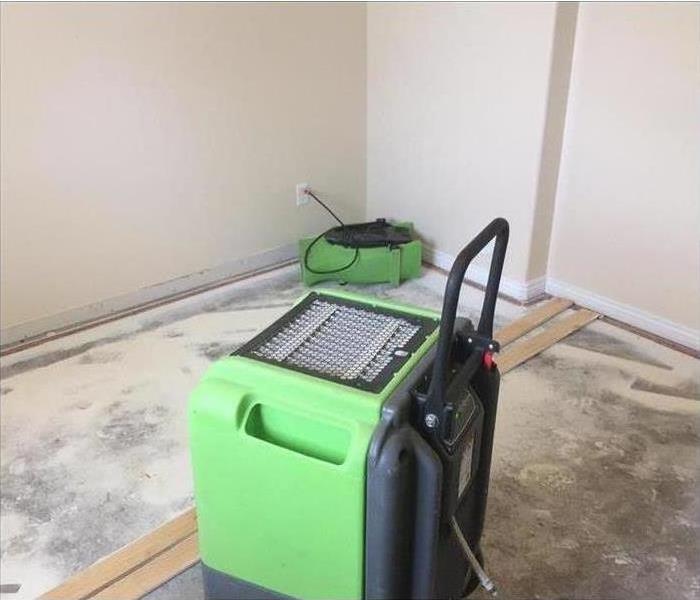 Water damage in a residential home in West Valley City, UT.
Water damage in a residential home in West Valley City, UT.
Insurance claims for water damage are on the rise. In fact, water damage claims are purportedly the second most reported petitions in West Valley City, UT. However, questions often arise when homeowners try to decipher the legal jargon of insurance policy, and many frequently become frustrated over exemptions and exclusions. Here are six hints to help you decode the steps you to take when making a water damage insurance claim.
6 Steps to Make a Water Damage Claim.
- Take pictures of the damaged area immediately after finding the water. Also, continue taking pictures during all stages of cleanup and restoration. If the damage is due to a pipe burst, take pictures of the pipe as well. Offer a copy of all photos to the insurance adjuster.
- Contact your insurance agent regarding the loss. Ask the agent questions about your coverage, the time limit to file a claim, and deductibles. Request information on repairs, restoration, and how long a claim takes to process.
- Establish your claim by filling out the claim forms as soon as you receive the papers. Return the completed documents to the insurance company right after you finish the paperwork.
- Keep a list of damaged and lost items. Include all steps taken to clean or discard major items, if possible. Also, take pictures and keep the photos with the records to substantiate the loss. If receipts are available for destroyed or damaged items, provide copies with your insurance claim.
- Request receipts and a detailed list of all work done by your water repair and restoration company. Also, ask the team to include a list of all supplies used to clean and sanitize the area.
- If your family needs to relocate during cleanup and restoration, keep receipts. Extensive records required may include living expenses, replacement clothing, and meal expenditures.
Once your insurance claim has been settled, and the insurance company accepts your submission, payment is typically sent to cover the terms of the settlement. If the claim is refused, you have the right to contest the refusal and the right to hire an attorney.
5 Signs You Have a Hidden Shower Leak
8/11/2022 (Permalink)
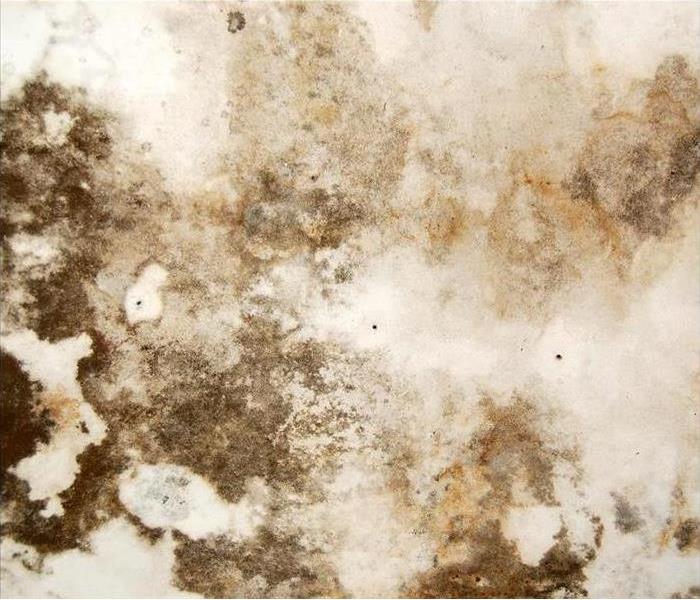 Presence of mold can be a sign of a shower leak in West Valley City, UT.
Presence of mold can be a sign of a shower leak in West Valley City, UT.
Residential plumbing is essential for the functionality of a house, but it is not uncommon for these systems to require maintenance. Unfortunately, it is not always apparent when corrective action needs to happen, like with a shower or bathtub leak. A water mitigation expert in West Valley City, UT, can provide some pointers on preventative steps to take, but you can never really know when a sudden leak will occur. To ensure that you find hidden leaks before they cause too much damage, consider the following five signs of a shower leak.
5 Signs Of A Shower Leak
- Presence of Mold or Mildew
Mold and mildew are indeed common in moisture-rich environments. However, if you are consistently finding mold or mildew around the shower faucet or head, then you may have a leak. To inspect, you will need to shut off the water supply and assess the faucets.
- Peeling or Flaking Paint
Another common sign of water damage from a bathtub leak is peeling or flaking paint. The peeling can suggest a leak behind the wall. The drywall is becoming damp, which is causing the adhesive of the paint to fail.
- Water Stains
If you have a shower on the second level of your home, then look for water stains on the ceiling of the lower level. The stains may appear grey or brown, depending on the damage.
- Sounds
When you turn your shower off, do you hear dripping? Continued water noises after the shower is turned off could indicate a leak in the line behind the wall.
- Loose Tiles
It is not uncommon for a shower pan leak to cause loose tiles around the tub. Water seeps around the drain, causing the subfloor to dampen and swell, which results in the tile breaking away from the floor.
A bathtub leak or shower leak is relatively common, but you do not want to let it fester. If you believe you have a leak, then contact a plumbing or water mitigation expert for help.
3 Common Causes of Water Damage in Your Home
7/12/2022 (Permalink)
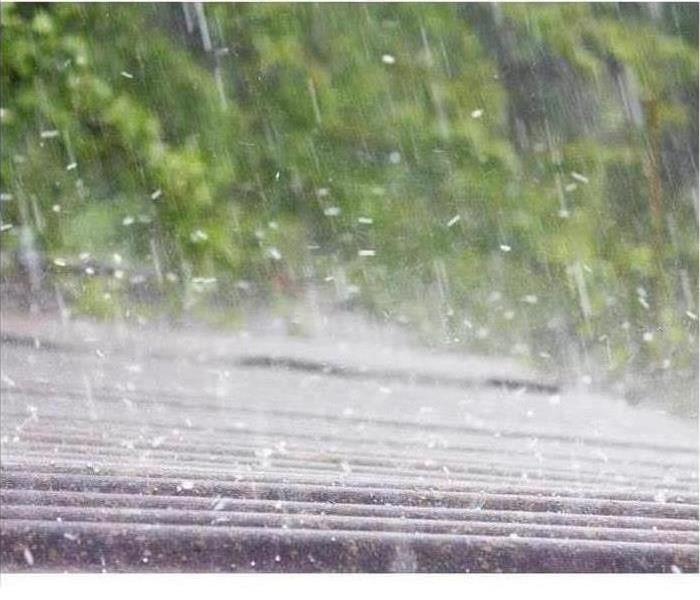 Hail damage can be a leading cause of water damage in West Valley City, UT.
Hail damage can be a leading cause of water damage in West Valley City, UT.
When Mother Nature has a bad day in West Valley City, Utah, sometimes you do too. Many different natural disasters can lead to flooding inside of your home. Unfortunately, even on a sunny day you can experience a pipe burst or water line break that causes the same result.
3 Leading Causes of Residential Water Damage
- Natural Disasters
Torrential downpours are not the only event in nature that can cause flooding in your house. Hurricanes, snowstorms, ice or hailstorms can be sources of water damage, and even fires can be a potential threat due to firefighting efforts. In any of these emergency situations, consider your safety first. After you and your family are out of danger, contact a storm damage and water restoration company that specializes in emergency services. From tarping a roof to prevent further damage to removing the excess flood waters, professionals can walk you through the steps needed to return your home to preloss condition.
- Broken Pipe or Line Break
When a pipe burst or water line break occurs, your house can become flooded with clean, uncontaminated water. In this situation, take action immediately to reduce the risk of secondary water damage. A water restoration specialist can inspect the damage and remove the standing water, and they can also dry, dehumidify and restore your home and its contents.
- Sewage Backup
A sewer backup is an emergency situation due to the level of contamination in sewage. Immediately leave your home and do not touch the contaminated water. Specialists typically arrive within a few hours with the appropriate equipment to safely remove the water and debris. Your home and possessions will be dried, sanitized and restored.
Whether the cause is from nature or a man-made source, flooding at your home in West Valley City, Utah, should be addressed promptly. When a rainstorm or pipe burst ruins your day, take action by calling in professional water restoration experts. Also, check with your homeowners insurance agent to see if water damage is covered under your policy.
How To Clean Valuable Items Damaged by Water in a Home
6/17/2022 (Permalink)
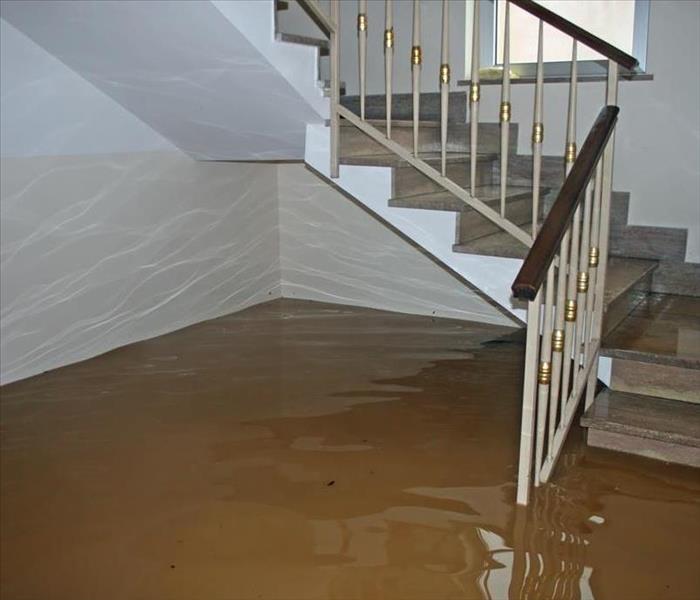 Your Valuable Items are also Valuable for us. Water Damage Specialists are ready to Help.
Your Valuable Items are also Valuable for us. Water Damage Specialists are ready to Help.
A broken pipe can cause a massive flood in your house that leads to thousands of dollars in damage. Yet fancy televisions and expensive cars are not always the most valuable items lost during a disaster.
Water can also harm treasured family heirlooms that are impossible to replace. Thankfully, with the help of water damage cleanup specialists, many of these items can be restored.
How To Salvage Items Damaged Due to Water in a Home
Even if you think the water in your West Valley City, UT, house is clean, it may be contaminated by unseen bacteria. You should thus wear the following whenever you touch the damaged items:
- Protective clothing
- Nitrile or vinyl gloves
- Respirator
- Goggles
Ideally, the remediation professionals will do most of the drying and dry cleaning. Here are some of the materials they can salvage.
Baskets
Twisting or wringing wet baskets could further damage them. Instead, the pros should get rid of the excess water by draining, blotting or rinsing the baskets. They should then put clean cotton sheets or paper towels inside the baskets. This should help the baskets maintain their shapes. The baskets should then be left to air dry.
Ceramics
Water in a home can cause pottery or ceramic materials to break. Do not attempt to glue them back together. Instead, place the broken items into labeled bags to keep everything organized. Once the pieces are dry, the restoration experts can decide the next steps.
Photos
Any wet photos need to be removed from their frames or plastic enclosures. To avoid further damaging the pictures, cut a slit in the enclosures so you can easily pull them away from the photos.
The restoration experts should take any pictures that are stuck together and place them in water. This should separate the photos. The pros will then either freeze- or air-dry the pictures.
Documents and Books
Important papers and documents can also be restored via freeze-drying. The restoration experts may have to rinse the materials first. The books should then be stacked spine-side down in strong containers. The containers will then be stored in a freezer that has a frost-free setting. Depending on the extent of the damage, the drying process could take weeks or months.
Art
Any pictures or art pieces behind a glass frame should be removed from the frame if possible. From there, the documents can be air-dried. If the item is stuck on the frame, keep it in the glass and turn it frame-side down to dry.
Paintings, meanwhile, should remain on the stretcher bars during the drying process. The pros should use distilled water and a clean sponge to remove any dirt or debris. As long as the paint is not flaking or cracking, the cleanup experts can blot the back of the paintings and then air dry them away from sunlight or heat. The paintings should instead be placed face-up on a surface that allows air to flow under the stretchers.
Even irreplaceable baskets, ceramics and photographs can be salvaged if they are harmed by water in a home. Emergency remediation specialists should help you enact the above strategies for restoring these items.
What To Do When a Pipe Breaks in Your Home
4/9/2022 (Permalink)
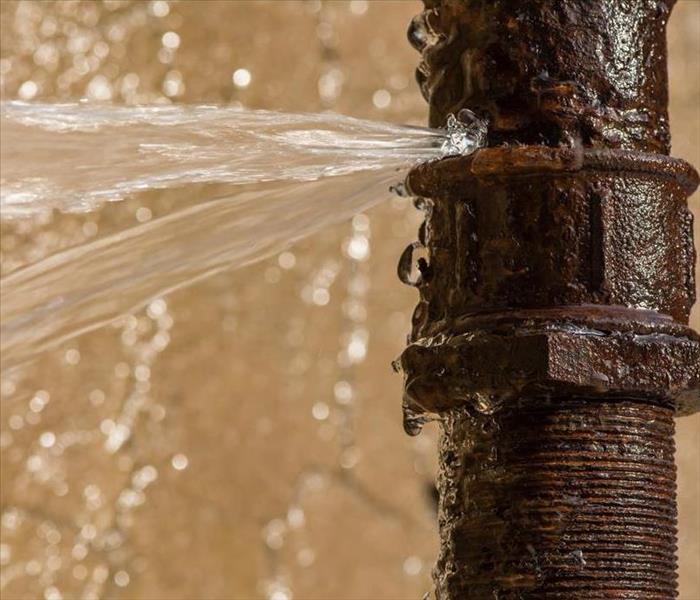 Tips to act Efficiently When a Pipe Breaks in Your Home.
Tips to act Efficiently When a Pipe Breaks in Your Home.
Bursting pipes can prove chaotic, expensive and time-consuming, filling a home with excess water and leading to significant overhauls. Those steel or copper tubes break for many reasons, including severe changes in pressure and temperature. In addition, corrosion and external objects may also cause unexpected and unpleasant busts.
Within seconds, homeowners in West Valley City, UT may face a fast-paced breach where water sprays throughout the room. How do you get it to stop? What action should you take? These bursts demand swift attention and thorough cleanup. Be ready for the unpredictable.
What can you Do to Reduce Water Damage?
The following are measures homeowners can take to reduce impact and begin essential home repairs.
1. Shut Down the Bursting Pipes
Above all, owners must focus on cutting off the water supply, thereby limiting the amount of moisture that enters the home. Although helpful to humans and plants, this water proves hazardous to structural materials. The dampness quickly saturates into porous materials. The wetness leads to rot, mildew and mold when allowed to linger.
Therefore, priority number one remains cutting off the flow. Stop, think and locate the closest shut-off valve. If the one in the home doesn't work, go outside and close the main outlet. Do whatever it takes to stop moisture from entering the premises.
2. Fix the Break
Contact professional water restoration services in West Valley City, UT to evaluate the situation. These experts should assist in locating the source of trouble. They should immediately fix broken pipe elements. With the original cause under control, owners may concentrate on salvaging and cleaning the damaged property.
3. Assess the Location
With the plumbing problem corrected, remediation specialists can examine the rooms for secondary damage, such as fluid buildup and microbial exposure. Using moisture reading meters, the team determines how much of the home suffered saturation. They may also take specimens from the walls, air and ceiling (anything impacted from the break), sending these collections out for testing.
The results allow experts to determine if pathogens inhabit the space. The professionals use the information to create a detailed plan to sanitize and restore the house.
4. Agree To Quick Tear Outs
Water damage, especially within a dark and humid space, activates spore reproduction. Therefore, the broken pipe leaves owners with more to consider than a plumbing bill and dampness. Owners must consider the possibility of mold development.
To curtail this predicament, permit restoration employees to remove materials of concern. The team may take out carpeting, drywall and belongings that suffered excess flooding. This decision reduces the number of spores and pathogens to safeguard from spreads.
5. Dry Out
Air out the room, concentrating on extracting as much water as possible from anything left. Remove any standing water, and use dehumidifiers to pull moisture from places you cannot touch or see. These devices use heat to pull fluid from those porous materials. This step helps you lessen the severity of the water conditions.
When you observe water spraying throughout the room or puddling up on the floor, don't panic; instead, kick into action. Immediately shut off the water supply and call for professional help.
Attend to the bursting pipes and initiate remediation efforts. Swift and efficient measures mitigate secondary damage, saving homeowners from further expenses and repairs.
My Basement Is Flooded! How Do I Remove the Water?
11/19/2021 (Permalink)
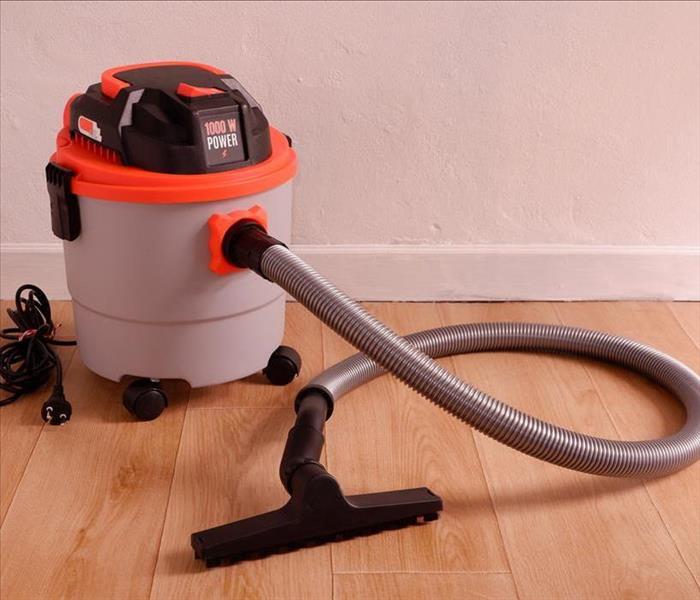 Take some preventive steps to avoid a basement flood in your West Valley City, UT, home.
Take some preventive steps to avoid a basement flood in your West Valley City, UT, home.
When you discover a basement flood in your West Valley City, UT, home, you are likely to have a range of emotions such as surprise, panic, and dread, and for good reason. The severity of water damage increases with every second, so it's essential to extract all the water as quickly as possible. It can also be hazardous, producing a risk of electrocution and creating a haven for mold growth.
First and foremost, shut the power off to the flooded area before anyone enters. If you can't safely navigate to the circuit breaker, call an electrician or the power company to turn it off. Also, stop the water at the source, if possible (e.g., from a burst pipe). If it originated from a hazardous source, such as a sewer backup, it is definitely time to call flood damage restoration professionals. They have the professional equipment and expertise to complete the remediation job safely thoroughly.
6 Methods for Eliminating Floodwater From a Basement
1. Sump Pump
A sump pump can give you some peace of mind during those heavy rainstorms. It'll help you avoid having to manually remove water from the area. It will also keep your home and its contents safer from water damage when you're at home and when you're away. Getting a sump pump installed in your home can provide a discount on your homeowners insurance coverage. If you already have one, make a point to test it and maintain it regularly so that it's there for you when you need it.
2. Wet/Dry Vacuum
A wet/dry vacuum provides perhaps the safest and most efficient way to extract water if you're doing it yourself. It's a great tool to have on hand for a quick cleanup. You can get wet/dry vacuums that hold various capacities of water. You'll just have to empty it when it gets full and then go back to work.
3. Buckets
Scoop up the standing water with flexible plastic buckets. One gallon of water weighs seven pounds, so this can be a very strenuous job. It's also not very efficient, but it's better than nothing.
4. Floor Squeegee or Push Broom
When you're dealing with a basement flood, after you've removed the majority of the water, you can push the rest of the standing water out the closest exterior door. A floor squeegee or push broom works well for this.
5. Mop and Towels
A mop will soak up residual water from a hard floor. Towels are good for absorbing any remaining puddles.
6. Air
Once all the standing water is removed, ventilate the area as much as possible. If the outdoor air is less humid than the indoor air, open windows and doors. Run fans and heat to remove the indoor humidity. Dehumidifiers are also very beneficial. Just remember to empty the water receptacle before it gets full.
If you have to deal with a basement flood once, you'll probably be motivated to avoid one at all costs in the future. Remember these tips so you can be prepared for a future disaster as much as you can.
Important Facts To Know About Sewage Cleanup
10/6/2021 (Permalink)
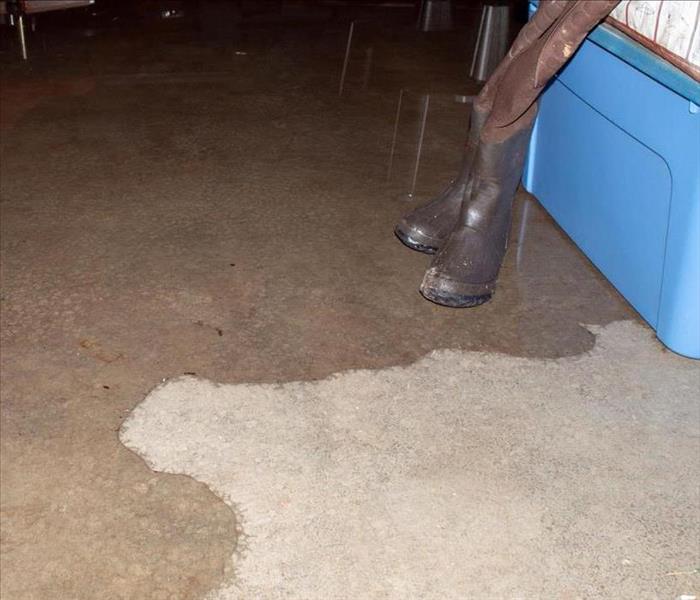 Protect yourself to clean sewage in your West Valley City, UT, building.
Protect yourself to clean sewage in your West Valley City, UT, building.
When you have raw sewage infiltrate your West Valley City, UT, commercial building, you can't treat it like an ordinary flood. Various situations can cause a sewage problem, such as a flooded toilet, clogged lines, or damage from tree roots. Whatever the cause, from start to finish, there are precautions that you need to take during the sewage cleanup to protect everyone involved as well as the building and contents.
How To Safely Clean After a Sewer Backup
1. Prioritize Safety
Block off the area so no one can enter, aside from people cleaning the room. Children, people with medical issues, and pets should stay out. Also, before anyone goes into the area, make sure that there are no electronics or appliances in the standing water, as an electric current could be flowing through the water. This issue can also occur when electrical outlets are exposed to the water. Turn off the building's power before stepping into the area.
2. Wear Personal Protective Equipment
Before going into the affected area, wear PPE to protect yourself from the contaminants. Safety goggles, a face mask, rubber gloves, and boots are musts. Water-resistant coveralls are also recommended.
3. Create a Barrier
Close off the contaminated area from the rest of the building. Blocking off the room can reduce the chance of cross-contamination of debris and airborne particles, and it works as a barrier to keep everyone out.
4. Extract Standing Water
Once you've identified the problem and stopped it, it's essential to remove all of the standing water. The safest and most efficient way of doing this is by using a wet/dry vacuum.
5. Remove Contaminated Materials
Remove all contaminated materials that can be removed from the area. During sewage cleanup, you must bag anything that isn't salvageable for the trash and dispose of it immediately. Items that can be adequately cleaned and sanitized should be sealed in bags and placed outside to handle later.
6. Remove Debris
After the area is clear of obstacles, it's time to clear the area of as much contaminated material as possible. You will probably have debris and could even have sludge. This material should be removed with a shovel, placed in heavy-duty plastic trash bags, and then immediately disposed of. If the flooring is soaked, you'll need to remove it, particularly if it's carpet. Wet areas of drywall will also need to be removed and thrown away.
7. Clean and Disinfect Everything
Clean and disinfect every affected surface. This washing is imperative to avoid serious issues, such as cross-contamination and mold growth. To ensure the job is performed safely and correctly, it's best to hire water damage, remediation professionals.
8. Dry Everything
Dry everything as quickly as possible to prevent mold growth. Mold can begin growing in as little as 24 hours, so it's critical to dry the area and contents thoroughly. You can use fans, dehumidifiers, and heat.
When you've had a sewer backup, taking specific steps in the raw sewage cleanup process is vital. By being thorough with this job, you'll protect not only your employees but also your building and its contents.
Pipe Burst? Don't Panic! Plan Your Response
9/15/2021 (Permalink)
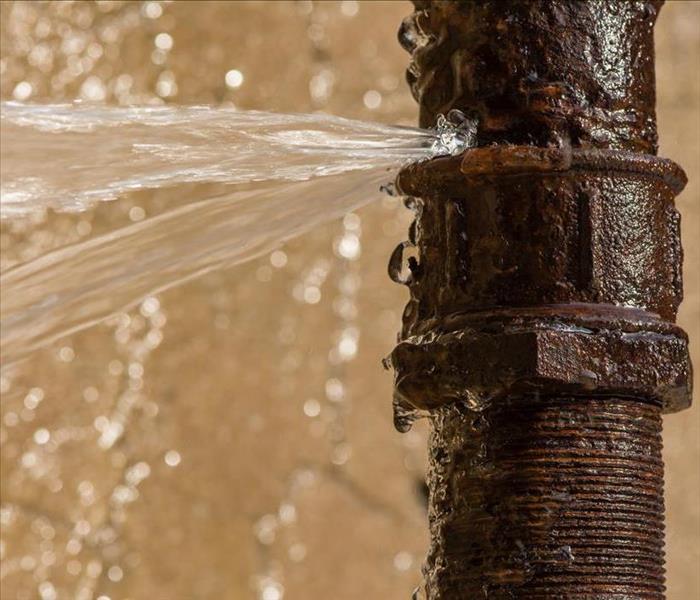 A pipe burst is the cause of water damage and leads to other severe damages.
A pipe burst is the cause of water damage and leads to other severe damages.
When dealing with a pipe burst, it's crucial that you take immediate action to prevent lasting water damage. Each minute that you delay increases the risk of extensive and costly damage, as well as disruption to your daily life.
Your Response to a Pipe Burst Situation
Prevent Bursting Pipes
Of course, prevention is the best course of action. When you know how to avoid the most common causes of the situation, you can significantly reduce the probability of flooding. Watch out for the following signs of trouble, especially along with your West Valley City, UT, home's main water line:
- Aging pipes may become cracked and weakened over time. Depending on the materials used to build the home, pipes may last between 20 and 50 years. Even if the rest of your home appears to be in good condition, if it was built in the 1970s or earlier, the pipes need to be replaced.
- Clogs from food, waste, and dirt create pressure along the pipeline.
- Corrosion can be recognized through visual inspections, a change of water pressure, or changes in the smell and color of the water coming through the pipes.
- Freezing temperatures affect pipes that run along exterior walls. As the water inside freezes or the metal pipes reach the freezing point, clogs or hot water can cause a burst.
Recognize a Water Leak
Sometimes, there's a clear gush of water that you can't miss, but at other times a cracked pipe happens out of sight. When this is the case, it's important to recognize signs of trouble at a hidden spot along the waterline. These include an unexplained increase in your water bill, increased sounds of water such as drips or running water behind the walls, puddles in the home, or signs of moisture on the ceilings or walls.
Turn Off the Water
As soon as you recognize a leak or pipe burst, shut off the water. If you aren't sure where the water is coming from, turn off the main valve. This may be in the basement, under the kitchen sink, or somewhere along the exterior of the home.
Disconnect the Electricity
Water and electricity are a dangerous combination. Shut off power to your home before coming into contact with any leaking water or moisture.
Drain the Pipes
With the water and power turned off, open the cold-water faucets throughout your home, flush the toilets, and open the hot-water lines to drain the pipes.
Repair the Broken Pipe
It may be possible for you to complete the necessary repair to a cracked pipe, but in some situations, a professional response may be required. The same is true when it comes to cleaning up and repairing areas damaged because of the water. Professional property cleaners do more than address visible damage; they also assess for hidden areas of moisture, the possibility of mold, and other vulnerable points along the water pipes.
Your first response to water gushing from a pipe may be a moment of panic, but when you have a plan in place, you're prepared to minimize the chaos. Protecting your West Valley City, UT, home from water damage begins long before you face the risk of a pipe burst.
How the Claims Inventory System Helps Insurance Agents
6/28/2021 (Permalink)
 Inventory System simplifies the work done by agents.
Inventory System simplifies the work done by agents.
Filing an insurance claim after flooding or a fire at your home in West Valley City, Utah, is one of the first tasks you'll complete to recover. At this point and throughout the process, it's important to work closely with your insurance agent. This professional may recommend the services of a preferred restoration provider, such as SERVPRO, in addition to working through the paperwork necessary to complete your claim.
What the Inventory System Provides
There are several reasons why insurance providers choose to work with preferred providers. SERVPRO, for instance, has a claims inventory system that simplifies the work done by the agent. The inventory system includes several components:
1. Database of Documentation
Every insurance claim requires a lot of paperwork and many details. A central database offering documentation pertinent to specific cases and with information from around the country makes it easier for agents to access and store photographs, written records, digital information, and anything else required to complete your claim.
2. Access From Any Location
You and your insurance agent may not be in the same place very often. When you add in the property damage cleanup and restoration technicians, as well as any other emergency response professionals, staying in touch and sharing information becomes complicated. The digital claims inventory system provides a central point of contact where information can be shared almost instantly. This speeds up the process of filing your claim and receiving the necessary funds.
3. Information for Tracking Claim Progress
It's important that your agent knows how repairs and your claim are progressing. This allows corrections and answers to questions to be handled quickly and accurately. Regular progress reports can also help you feel more comfortable about the work being done in your home. With convenient access to this information, you and your agent can be aware of the severity of damage and the need for further work.
This digital inventory system is helpful in completing your insurance claim quickly and accurately. The benefits provided through the system make it popular with agents from many insurance providers.
Help! My Toilet Overflows When I Take a Shower!
4/15/2021 (Permalink)
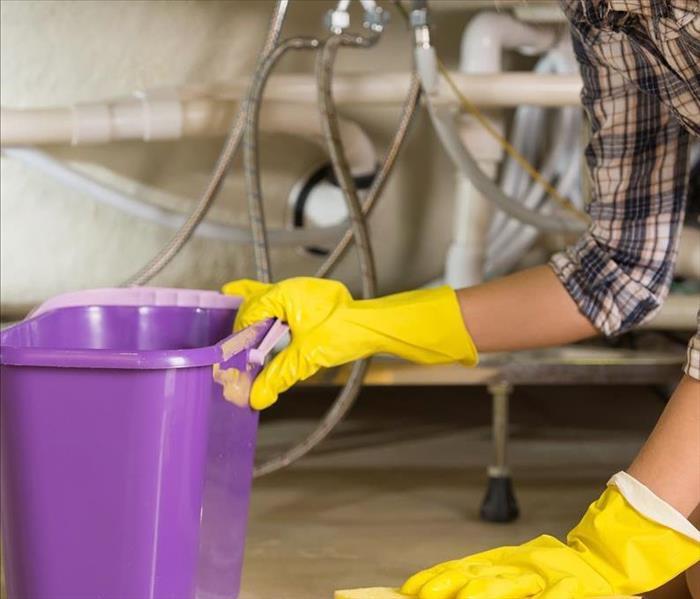 Clear a clogged pipe as soon as possible.
Clear a clogged pipe as soon as possible.
Is your toilet gurgling or overflowing when you take a shower? If so, there's probably a blockage somewhere between the main sewer line and the toilet. This obstruction will cause the shower water to back up. Home bathrooms are often designed so that the water from the shower travels to the toilet drain first. This can result in a toilet overflow. After performing sewage cleaning once, you're going to want the issue resolved as soon as possible. There are several ways to try to deal with the clog yourself if you don't want to hire professionals right away.
Ways to Deal With a Clog
Plunge the Toilet
A toilet plunger can often dislodge an obstruction in the line. Any plunger is better than none, but the best is one with an extra rubber flange built-in. This will create a tighter seal when plunging. If you see any materials coming up from the bottom of the bowl, this could indicate that a clog is breaking up. This could be messy if there's a significant blockage that breaks free and causes another toilet overflow. The assistance of sewage cleaning experts can ensure proper cleanup and sanitization.
Snake the Toilet
A plumber's snake or auger is a long cable with a corkscrew end. There are a few different varieties, but they all work by feeding the wire through the drain line and turning the corkscrew to dislodge blockages. Try to feel for obstructions as you're feeding it down the line.
Clear the Drain Cleanout
Your West Valley City, UT, home should have a drain cleanout plug where your drain line ends (e.g., crawlspace, basement or outside). Look for a large screw-on cap (i.e., the plug) in one of these areas. Remove the plug and feed the snake down the drain to remove any obstructions. A blockage may be further down the line, in which case you'll probably need to hire a professional plumber.
You must clear a clogged pipe in your bathroom line as soon as possible. You can probably avoid further problems, including a disgusting sewage cleaning job.
How Drain Cleaners Might Cause More Harm Than Good
3/29/2021 (Permalink)
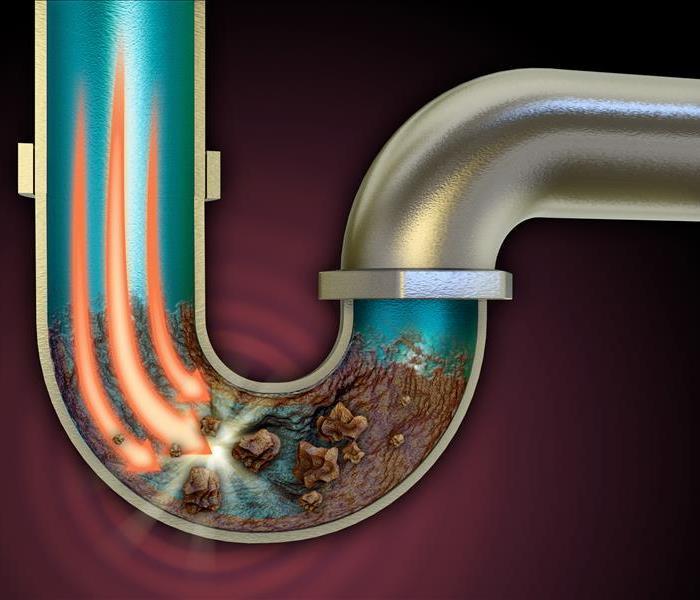 Drain cleaners can damage your pipes.
Drain cleaners can damage your pipes.
Nothing is more annoying than a clogged drain when you are in a rush. It might be tempting to pour a cleaning agent into it and hope for the best, but this can cause more harm than good. Some homeowners find themselves with more plumbing problems than they planned on when using store-bought products to clear a clog.
Drain Cleaners Cause Damage
Unfortunately, sometimes your typical clog remover is one of the worst things you can put down a drain. You do not want to use drain cleaner on:
- Older pipes
- Weak pipes
- Metal pipes
- Pipes that are completely blocked
It can even cause harm when your pipes are new. Most of these cleaners contain caustic chemicals, and if you use them incorrectly, they can cause a leak. This causes water damage, and you will find yourself calling a sewage cleaning company in West Valley City, UT, to fix the problem.
A good rule of thumb is always to read the directions on any drain opener very carefully. The instructions will tell you exactly how to use it on a clogged drain. The majority of cleaners specifically say not to use it when your pipes are completely blocked. Pouring a cleanser down a completely blocked pipe can cause the cleaner to weaken your pipes.
Calling the Professionals
Sometimes it is necessary to call a professional to take care of the problem. A drain clog can be an indicator of a much larger problem. This is particularly true if the problem is in your toilet. Multiple bends could be clogged, and there is a good chance that what you are dealing with is raw sewage. This can be dangerous if you are not wearing the proper protective gear.
Drain cleaners are not always the best solution for dealing with a clog. They can damage your pipes, cause sewage leaks and generally make things worse. A clogged drain doesn't have to be a big deal, but you do need to be careful about what you use to fix it.





 24/7 Emergency Service
24/7 Emergency Service













